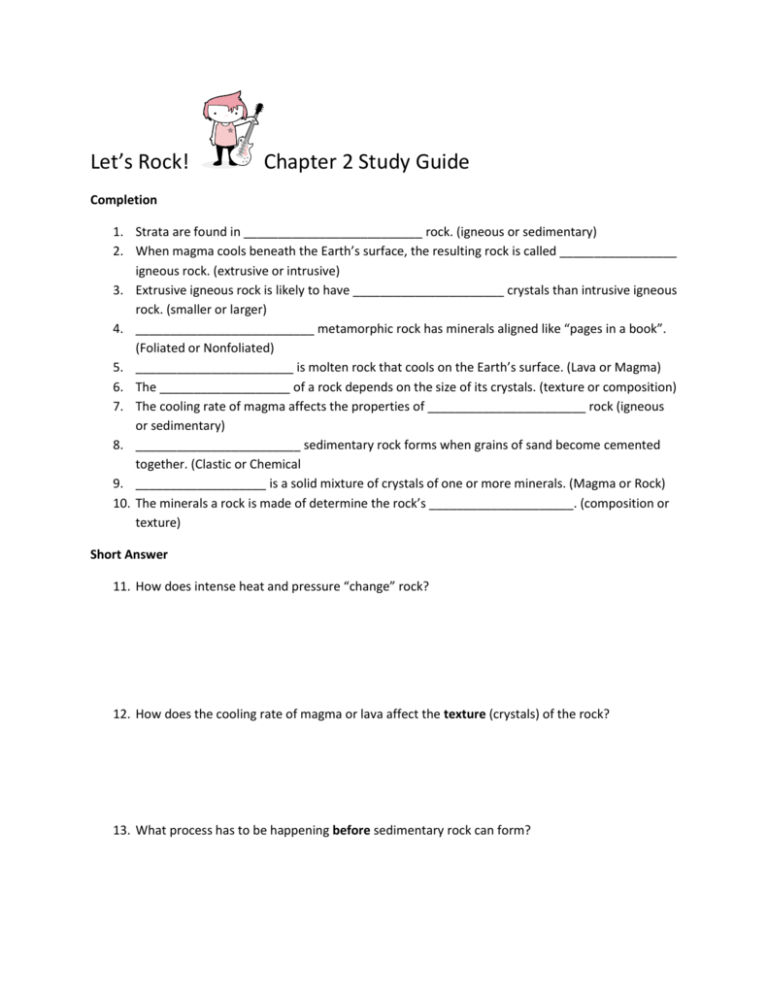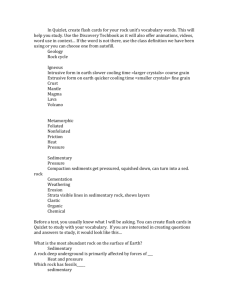Let`s Rock! Chapter 2 Study Guide Completion Strata are found in
advertisement

Let’s Rock! Chapter 2 Study Guide Completion 1. Strata are found in __________________________ rock. (igneous or sedimentary) 2. When magma cools beneath the Earth’s surface, the resulting rock is called _________________ igneous rock. (extrusive or intrusive) 3. Extrusive igneous rock is likely to have ______________________ crystals than intrusive igneous rock. (smaller or larger) 4. __________________________ metamorphic rock has minerals aligned like “pages in a book”. (Foliated or Nonfoliated) 5. _______________________ is molten rock that cools on the Earth’s surface. (Lava or Magma) 6. The ___________________ of a rock depends on the size of its crystals. (texture or composition) 7. The cooling rate of magma affects the properties of _______________________ rock (igneous or sedimentary) 8. ________________________ sedimentary rock forms when grains of sand become cemented together. (Clastic or Chemical 9. ___________________ is a solid mixture of crystals of one or more minerals. (Magma or Rock) 10. The minerals a rock is made of determine the rock’s _____________________. (composition or texture) Short Answer 11. How does intense heat and pressure “change” rock? 12. How does the cooling rate of magma or lava affect the texture (crystals) of the rock? 13. What process has to be happening before sedimentary rock can form? True or False? 14. 15. 16. 17. 18. _____________ Extrusive igneous rock cools very slowly from lava _____________ Weathering and erosion can only break down metamorphic rock. _____________ The minerals that a rock is made of determine its composition. _____________ The texture of an igneous rock depends on how fast the lava or magma cooled. _____________ Both lava AND magma can cool to form metamorphic rock. Multiple Choice 19. Sedimentary rock is formed when grains of sediment undergo a. compaction and cementation. b. metamorphism. c. melting. d. solidification. 20. At what temperatures do lava and magma solidify, or “freeze”? a. Anywhere below 0°C b. between 500°C and 600°C c. between 700°C and 1,250°C d. Anywhere below 1,000,000°C 21. Most volcanic rock is a. sedimentary. b. intrusive. c. extrusive. d. as cool as the other side of the pillow. 22. Which type of rock only forms at or near the Earth’s surface? a. igneous rock b. sedimentary rock c. metamorphic rock d. all of the above 23. Millions of years of erosion by the Colorado River have exposed ____, or layers, of sedimentary rock in the walls of the Grand Canyon. a. dikes b. sills c. strata d. batholiths 24. Which of the following is the correct order of steps in the formation of sedimentary rock? a. erosion, deposition, compaction and cementation b. deposition, erosion, compaction and cementation c. compaction and cementation, deposition, erosion d. conjunction junction, what’s your function? 25. Fossils are the remains or traces of plants and animals that have been preserved in ___ rock. a. granite b. igneous c. sedimentary d. metamorphic 26. Most fossils come from animals that lived a. in the oceans. b. on mountain tops c. in tropical rain forests. d. in deserts. 27. Which type of rock can change into metamorphic rock? a. igneous rock b. sedimentary rock c. metamorphic rock d. all of the above 28. Which of the following statements are true about metamorphism? a. Metamorphism melts rock into magma. b. Metamorphism is caused by heat and/or pressure. c. Metamorphism generally occurs very deep within the Earth. d. Metamorphism causes rocks to appear “cooked” or squeezed. Congratulations. You are now a Rock Star!







